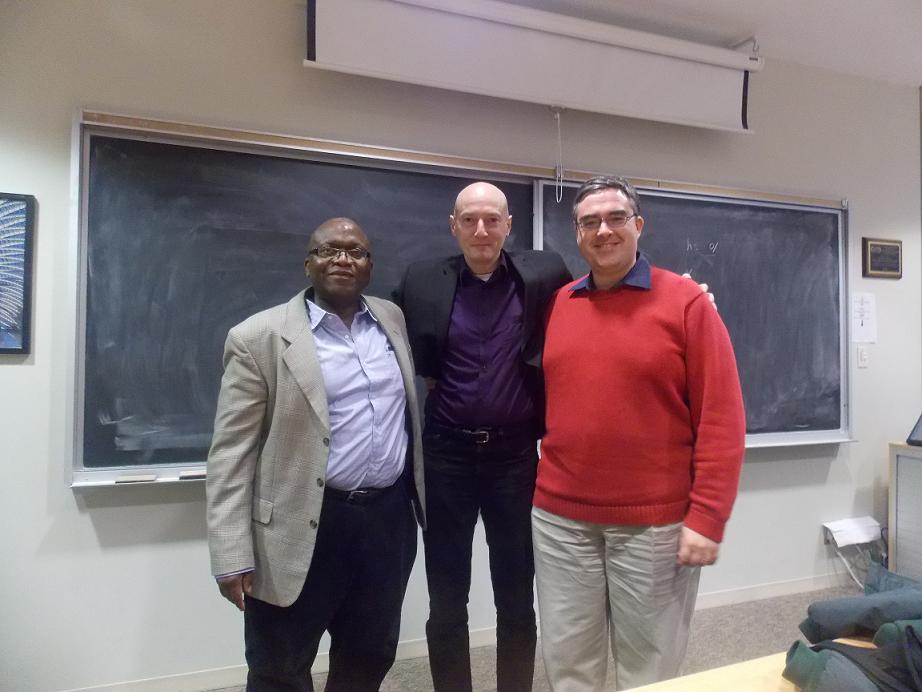 |
|
THE
FIELDS INSTITUTE FOR RESEARCH IN MATHEMATICAL SCIENCES |
2014-15
Fields
Industrial Optimization Seminar
at 5:00 p.m.
at
the Fields Institute, 222 College St., Toronto
|
 |
|
The inaugural meeting of the Fields Industrial Optimization Seminar
took place on November 2, 2004. The seminar meets in the early evening
of the first Tuesday of each month. Each meeting is comprised of
two related lectures on a topic in optimization; typically, one
speaker is a university-based researcher and the other is from the
private or government sector. The series welcomes the participation
of everyone in the academic or industrial community with an interest
in optimization – theory or practice, expert or student . Please
subscribe to the Fields mail list to be
informed of upcoming seminars.
The Fields Institute makes a video record of this seminar through
FieldsLive. If you make a presentation
to the Seminar, the Institute will be video-recording the presentation
and will make the video record
available to the public.
| Seminars |
|
May 25, 2015

Click for larger size
|
Stéphane Gaubert (INRIA and École Polytechnique)
Tropical geometry, Perron-Frobenius theory, and mean payoff games
We will survey some relations which have recently emerged between
non-linear Perron-Frobenius theory, tropical geometry, and zero-sum
repeated games. Perron-Frobenius theory deals with linear maps leaving
a cone invariant. Tropical objects, like polyhedra, or semi-algebraic
sets, arise as images by log-glasses, or by non-Archimedean valuations,
of the same objects over fields. We shall see that by applying log-glasses
to non-linear Perron-Frobenius maps, we end up with Shapley operators
(dynamic programming operators of zero-sum games). Moreover, the sub
or super fixed points of these operators provide optimality certificates
for the mean payoff criteria. Finally, mean payoff games will be shown
to be equivalent to feasibility problems in tropical linear programming,
whereas zero-sum stochastic games will be reduced to feasibility problems
in tropical convex programming. This talk is based on a work with
M. Akian and A. Guterman. It will also cover more recent materials
with X. Allamigeon, P. Benchimol, and, M. Joswig.
Pascal Benchimol (EDF Research Center)
Applications of tropical geometry to linear programming and mean
payoff games
We present two results obtained from applying the viewpoint of tropical
geometry to linear programming. Tropical geometry is the algebraic
geometry over semirings such as the real numbers endowed with the
maximum as the first operation, and the sum as the second. Tropical
geometry arises as a logarithmic limit of classical geometry. In particular,
the tropical analogue of a linear program is a logarithmic limit of
a classical linear program, that yet retains much information on the
classical problem. Using this approach, we exhibit a counter-example
to the continuous analogue of the Hirsch conjecture, that is we present
a family of classical linear programs with 3r+4 inequalities in dimension
2r+2 where the central path has a total curvature which is exponential
in r. Tropical linear programs are equivalent to a class of infinite
two player games, called mean payoff games, whose complexity status
is still unsettled. By tropicalizing the simplex method, we obtain
the first algorithm that solves mean payoff games in polynomial time
on average. This talk is based on a joint work with X. Allamigeon,
S. Gaubert and M. Joswig
|
|
March 16, 2015
Location:
Stewart Library

Click for larger size
|
Miguel Anjos, Ecole Polytechnique Montréal
Current Challenges and Recent Progress in Optimization for the Smart
Grid
A smart grid is the combination of a traditional power distribution
system with two-way communication between suppliers and consumers.
This combination is expected to deliver energy savings, cost reductions,
and increased reliability and security, but smart grids introduce
numerous challenges for the management of the resulting system. These
include integrating renewable energy sources such as wind and solar
electricity generation, managing bidirectional flows of power, and
incorporating demand-response. We will present an overview of the
challenges in this area, and examples of how optimization is helping
to meet these challenges.
Innocent Kamwa, Hydro-Québec
Applications of Optimization to Improve Performance of Power Transmission
Networks
Hydro-Québec's electrical transmission system is an extensive,
international grid with extensions into the northeastern United States
of America. For such large power systems, one of the major issues
is to ensure reliability while improving the steady-state and dynamic
performances of the network. We will present different ways in which
optimization algorithms can be applied in this context, such as the
optimal location and rating of flexible AC transmission system devices,
the design and coordination of damping controllers, and the optimal
allocation and scheduling of multiple battery energy storage systems
to improve energy efficiency.
|
|
December 9, 2014

Click for larger size
|
Paul McNicholas, McMaster University
Multiple-Scale Asymmetric Clustering
Finding groups of points within data can present a challenging problem.
This is especially so when data are asymmetric and/or high-dimensional.
While clustering high-dimensional data has garnered much attention
for the past decade or so, clustering asymmetric data has only recently
become the subject of significant research endeavour. This talk aims
to address the problem of clustering asymmetric data in a manner that
can easily be extended to high-dimensional data. The approaches that
will be discussed are based on extensions of a mixture of generalized
hyperbolic distributions. Issues around cluster convexity and parameter
estimation will be discussed. Examples will be used for illustration.
Mark-John Bruwer, Prosensus
Rapid development of new products via advanced statistical modeling
and optimization
Today manufacturers face fierce competition to establish, maintain
and grow market share for their products. Product lifetimes for many
food or chemical products can be as short as a year or less. Traditional
approaches to product development typically require 2 to 5 years to
take a new product from conception to commercial launch. Therefore
there is an urgent need for more effective and efficient methods to
navigate the product development process.
This talk will present an approach to product development that has
shown considerable success for ProSensus clients in the food and chemical
industries. The method is based around the use of latent variable
models that combine raw material properties, product formulation,
and process operating conditions into an integrated model that predicts
the key quality attributes of the desired product. The latent variable
approach can often achieve a significant dimension reduction for the
product development problem, enabling the space to be explored with
significantly fewer experiments, saving time and money. Once a reliable
model is attained, numerical optimization is applied to it to generate
candidate designs that specify the product formulation and process
operating conditions that achieve the desired product. Typically multiple
solutions are possible, enabling secondary optimization criteria to
be introduced, such as minimizing the cost of the selected raw materials,
using more reliable suppliers, etc.
We believe this technology has the potential to revolutionize the
way product development is implemented.
|
|
October 14, 2014

Click for larger size
|
Tamás Terlaky, Lehigh University
Optimization Theory and Dynamical Systems : Invariance and Invariance
Preserving Discretization Methods
First we present a novel, unified, general approach to investigate
sufficient and necessary conditions under which four types of convex
sets, polyhedra, polyhedral cones, ellipsoids and Lorenz cones, are
invariant sets for a linear continuous or discrete dynamical system.
The Farkas Lemma and the S-lemma are the key tools in deriving sufficient
and necessary conditions for invariance.
Second, we consider invariance preserving step-length thresholds
on a set when a discretization method is applied to a continues linear
or nonlinear dynamical system. Our main result, both for linear and
nonlinear dynamical systems, is the existence of a uniform invariance
preserving step-length threshold for a large class of discretization
methods for convex compact sets, and proper cones.
Third, the computation of step-length thresholds for invariance preserving
of some classes of discretization methods on a polyhedron are considered.
For for rational function type discretization methods a valid step
length threshold can be obtained by finding the first positive zeros
of a finite number of polynomial functions.
Finally, for the forward Euler method, the largest step-length threshold
for invariance preserving is presented by solving a finite number
of linear optimization problems.
Piyush Grover, Mitsubishi Electric Research Laboratories
Dynamical systems and optimization: Exploiting structure in nonlinear
systems
Nonlinear systems of mechanical origin often have structure that
can be uncovered via various methods of dynamical systems. This structure
can often lead to simplification of optimal design problems. We use
geometric, topological and statistical methods to uncover this structure
in problems in astrodynamics and micro-fluidics. First we discuss
the geometric structure of the restricted three-body problem. We use
this structure to construct nearly optimal solutions to global optimal
control problems in mission design.
Next, we discuss the topological nature of mixing and transport in
two-dimensional fluid mechanics. The main theorem we use here is the
Thurston-Nielsen classification theorem (TNCT), which can be used
to give lower bounds on topological entropy for flows with periodic
orbits. We use statistical methods to construct almost-invariant sets
in more general flows, and make the case that a topological analysis
based on spatiotemporal braiding of almost-invariant sets can be used
for analyzing and optimizing chaos in fluid flows.
|
Back to top
|
 |

